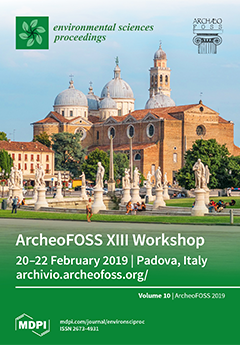Environ. Sci. Proc., 2021, ArcheoFOSS 2019
ArcheoFOSS XIII Workshop—Open Software, Hardware, Processes, Data and Formats in Archaeological Research
Padova, Italy | 20–22 February 2019
Volume Editors:
Sara Gonizzi Barsanti, The University of Campania Luigi Vanvitelli, Italy
Saverio Giulio Malatesta, Sapienza University of Rome, Italy
Augusto Palombini, Consiglio Nazionale delle Ricerche (CNR), Italy
- Issues are regarded as officially published after their release is announced to the table of contents alert mailing list.
- You may sign up for e-mail alerts to receive table of contents of newly released issues.
- PDF is the official format for papers published in both, html and pdf forms. To view the papers in pdf format, click on the "PDF Full-text" link, and use the free Adobe Reader to open them.



